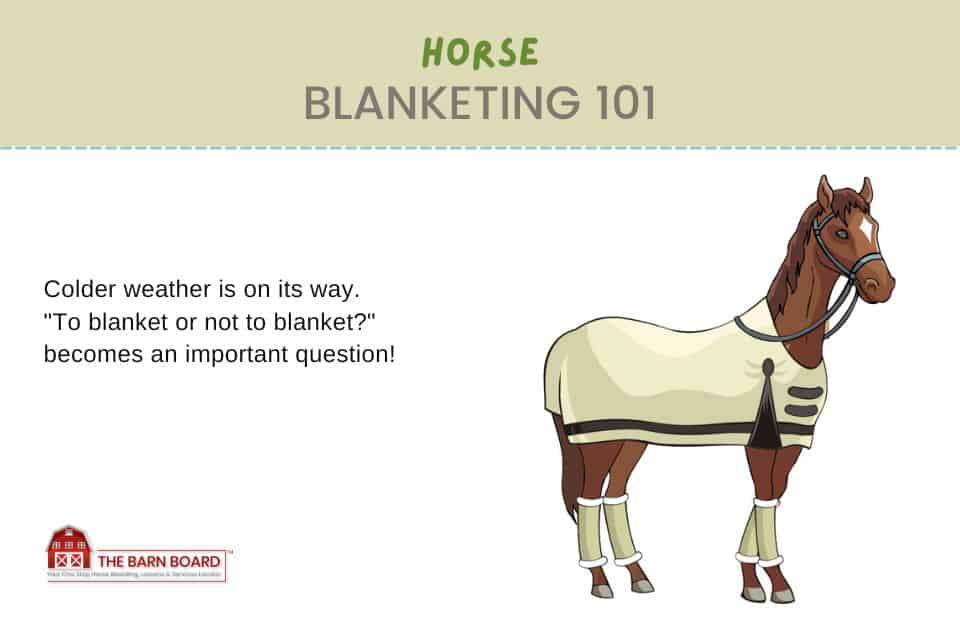To blanket or not to blanket? That is one of the most significant questions any horse owner asks themselves when the cold weather rolls in.
Although, it is important to consider that blanketing is not only a question for winter, and there are many factors to think about before blanketing. These include making the correct blanket choice, taking into consideration your horse’s current condition along with environmental factors, and maintaining/storing your blanket(s).
Choosing the right blanket(s) depends on every individual horse’s situation and the environment they are based in.
Start by determining the correct size for your horse using a tape measurer placed on the center of his/her chest and get a helper to stretch out the tape to the point of buttock. Be sure that your horse is standing squarely and that you run the tape straight across from point to point.
Climate is perhaps the most obvious element to factor in when selecting a rug. For the colder, extreme winters like those seen in Canada, a good blanket would be hardy, ventilated, and waterproof.
Look for blankets with increased denier, as this means that the fabric will be stronger and less susceptible to damage. Fill (also called polyfill, the batting within the blanket) shows how heavy/warm the blanket is based on weight. A lightweight rug is about 100 to 200 grams, while heavyweight blankets can exceed 350 grams.
Additionally, consider purchasing blankets with hydrophilic coating on the inside and Aquatrans on the outer layer, as this provides waterproofing for several years.
Heavier blankets nowadays often come with liner systems which allows for additional, lighter rugs to be put under the outer layer. This is not only convenient in extreme cold, but also allows for easier washing, thus keeping your horse’s skin safe from bacterial buildup.
Once you get a blanket, make sure your horse feels comfortable with all of the straps prior to turning him out (or you might end up with no blanket left once you go to catch him/her).
When figuring out when it is time to blanket your horse, first take into account your horse’s current condition:
- Is he/she clipped?
- Does he/she have a naturally cooler temperature than others?
- Does he/she live inside or outside?
When it comes to blanketing unclipped horses, note if any of the two of three factors are present: wet, wind, or cold.
Unclipped and young horses may need less or even no blankets in cold weather, but it is best to have waterproof/windproof blankets in case of severe weather changes.
Older horses and horses with health problems (even if they are kept unclipped) may need more assistance keeping warm, so when it is windy and chilly blankets become a must.
The general rule of thumb for clipped horses is not to blanket or use a sheet in weather above 10°C, and use a heavyweight with added rugs/covers in temperatures below -12°C.
However, blanketing isn’t just limited to the cold months.
During the warmer weather (summer especially), your horse may benefit from a sheet which provides protection against UV rays and flies (WeatherBeeta).
Start thinking about what your horse may need well before the weather changes; summer rugs are usually discounted during the winter season!
Storage and maintenance of blankets is just as important as choosing the right one.
Besides ensuring that none of the surcingles and straps are broken, it is also important to keep your blankets clean in order to increase their longevity. It may take work, but it will save you money in the long run.
When needed, don’t cheap out on repair as this can be less expensive than having to pay the vet bills for a horse injured due to blanket breakage. Keep your blankets in a safe storage place and be sure to give them a thorough check well before you start using them again.
Blanketing can be a relatively simple task as long as you blanket each horse as an individual, think of what blankets you need well before the time comes, and maintain your blankets when they are not in use.
Every horse will have his/her preferences that they may show in subtle ways.
As horse owners, it is our job to notice what our horses like and don’t like by observing and feeling.
Check for sweating and rubbing daily because sometimes blankets can do more harm than good. Do your research, note down your observations, make the proper changes (if necessary) and your horse will surely feel at ease.


